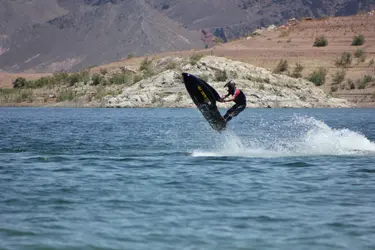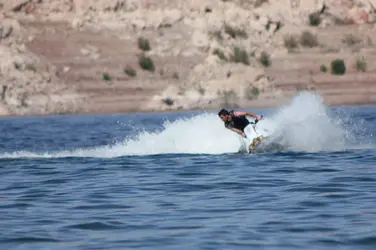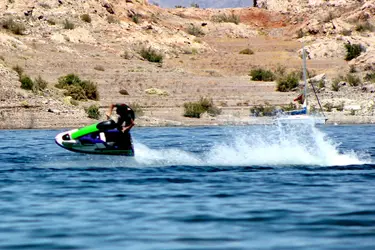i just purchased my first dslr camera two weeks ago.(canon rebel t2i) i will mostly be taking action pictures of dirtbikes and jetski's probably from a longer range as well. any tips or suggestions?
Yes. Keep the camera out of the dirt and out of the water. 
i already figured out autofocus isn't always the best thing because it tends to focus on the background rather than the subject when it's in motion. or at least that was my experience. i will post pictures later tomorrow with what i came up with last weekend. my computer is running really slow right now. thanks for any advice.
Your skill generally always trumps the camera capabilities (unless the camera is really limited... but a T2i is a fairly capable camera.) A bit of learning and practice on your part and you'll have much better luck.
You didn't mention which lens(es) you have. The consumer-grade zooms (e.g. the EF-S 18-55mm f/3.5-5.6 IS "kit" lens that comes with the camera as well as the EF-S 55-250mm f/3.4-5.6mm IS telephoto zoom that a lot of people buy) don't have "USM" focusing motors. The USM focus motors are quiet but more importantly, they're much faster (and some of them are faster than others.)
Which lens(es) do you have?
If the action is coming toward you (or away from you) then the focus distance is changing constantly while you're trying to take the shot. This means that (a) you need to change the camera's focus mode to "AI Servo" (the default mode is "One Shot" -- which you'd use for non-moving subjects... use "AI Servo" for moving subjects) and (b) it means that the auto-focus on the lens has to be able to keep up. USM motors generally can keep up. Non-USM motors may have trouble. If you left the camera in the default "One Shot" mode then the camera would have locked the focus at the point where the subject used to be.... and then took the shot, but of course by then the constantly-moving subject will no longer be at the focused distance. The result is a LOT of blurry shots.
To compensate, and since you're shooting in bright light, I suggest you use high f-stop values. In "bright sun" (e.g. the jet ski) the exposure follows the "Sunny 16" rule -- this is a baseline rule. It says that you can set the f-stop to f/16 and set the shutter speed to the inverse of the ISO speed. So at ISO 100, you'd use 1/100th sec exposures (it turns out 1/125th is the nearest "standard" shutter speed but most digital camera can shoot at 1/100th). You can also use any "equivalent" exposure. In other words if you open the aperture by 1 full stop (e.g. use f/11 instead of f/16) then you could speed up the shutter by 1 full stop.
1/100th (or 1/125th) is not fast enough to "freeze" action. Generally 1/500th is the speed that freeze action (and it turns out if the subject is coming toward you rather than moving sideways -- left/right or up/down movement) then you don't need the full 1/500th... usually 1/250th will do. If you bump up the ISO speed by 2 stops (so you'd go from ISO 100 -> 200 -> 400) then you can speed up the shutter by 2 stops (1/125th -> 1/250th -> 1/500th) (do not worry that you're at 1/500th and the ISO is at 400... that's only 1/5th of a stop difference and not enough to have a real impact on the exposure.)
I'd also suggest you pick a specific focus point rather than let the camera auto-focus. You can start by forcing the camera to use the center focus point and just make sure that spot is on your subject. You can experiment by letting the camera auto-choose the focus point. But keep in mind that it'll gravitate to the nearest object it can find that allows it to lock focus.
One VERY IMPORTANT tip about "AI Servo" mode: In "One Shot" mode (the default focus mode), the camera is also using something known as "focus priority". This means that if you merely point at something and mash the shutter button all the way to take shot, the computer will FORCE the camera to focus (as long as you haven't disabled autofocus) and the shutter will NOT take the shot UNTIL the computer believes it has locked focus on at least one focus point. This reduces the number of blurry shots you get (the focus point the computer chose may not have been on your subject, but it will have used *some* focus point.) When you switch to "AI Servo" mode, this changes. The camera is now in "release priority" mode. That means if you mash the shutter button all the way down, then your camera WILL take the photo NOW... whether anything was focused or not is irrelevant. It takes the photo when you demand the shutter take the shot... no matter what. THAT MEANS that when you're in AI Servo mode you do want to make sure that visually your subject appears to be in-focus. You may also want to make sure you've got the camera setting enabled that makes the select focus point blink red when it locks focus. There's also an option to chirp but I suspect with the noise of the action around you it may not be easy to hear the chirp.
The reason for f/16 is that you get a VERY broad depth-of-field (DoF). This means that the range at which seems to be reasonably well focused is quite deep... both near and far subjects will seem to be pretty sharp. That gives you a HUGE margin of error if the camera misses perfect focus. If you drop down to f/5.6 then that range gets shallow and missing focus will be quite noticeable. With faster USM lenses, you could decrease the ISO and close down the aperture to reduce the DoF. This means that in the dirt-bike shots, the crowds in the background will be blurred instead of sharp -- and some people prefer this look because it helps your subject stand out more ... as they're the only thing in sharp focus. But I'd "start" with f/16... get some practice, and work your way down as you gain confidence in your own skill and in the capabilities of your camera.
Since your subjects are moving, you can get artsy by practicing a technique called "panning". For panning, you drop the shutter speed back down... say 1/125th or may even 1/60th... but the trick with panning is that the camera must "track" the subject (if you just hold the camera still then the subject will be blurred by the motion). If you can accurately track the subject then you get a sharp subject, but the background will have a very obvious "motion blur" to it... this "implies motion" to anyone who looks at the photo. Rather than freezing time, you definitely get the idea that the subject was moving with some speed. This technique takes PRACTICE. Don't expect to nail these shots... expect a lot of throw-aways before you get a keeper. Work at it and you can increase your "keeper" ratio over time.
Summary:
Switch focus to "AI Servo"
Select center point as active focus point (don't let camera auto-select.)
Set ISO to 400
Set shutter speed to 1/500th
Set f-stop to f/16
If you prefer to use an auto-mode then select "Tv" mode, set the ISO to 400 (don't let it do auto-iso) and set the shutter speed to 1/500th... the camera will then auto-select the aperture (and it'll usually pick something close to f/16 in full sun.) But a word of warning... the light meter in the camera can be confused by reflections.
Track the subject to make sure the center focus point stays on your subject.
Half-press the shutter button and make sure your subject appears sharp before you fully-press the button to take the shot. The camera will continue to update the focus as the subject moves but if you press the button too soon then it'll take the shot before it could achieve focus.
For advanced fun: start dropping the shutter speed.... try 1/250th, then 1/125th, then 1/60th. Track the subject "carefully" so that their apparent position does not change within your viewfinder and only the background is moving. If you're in Av mode the camera will auto-compensate by changing the aperture for you. If you're in "M" then you'll need to decrease the f-stop by 1 full stop each time you slow down the shutter.
Good luck! Don't forget to post your results. We want to see how you do.








![[No title]](/data/xfmg/thumbnail/38/38749-a4ef503184d13a9c7592221cb44ac5e8.jpg?1734172603)



![[No title]](/data/xfmg/thumbnail/38/38292-ab7b4579becf6f3bda3ef5b18219d707.jpg?1734172201)

![[No title]](/data/xfmg/thumbnail/38/38748-ed31bfa7e0ad498ba3aa5dfbf3666f8d.jpg?1734172603)
![[No title]](/data/xfmg/thumbnail/38/38747-bbe463248feefb7affb6b5e00efb70c6.jpg?1734172603)

